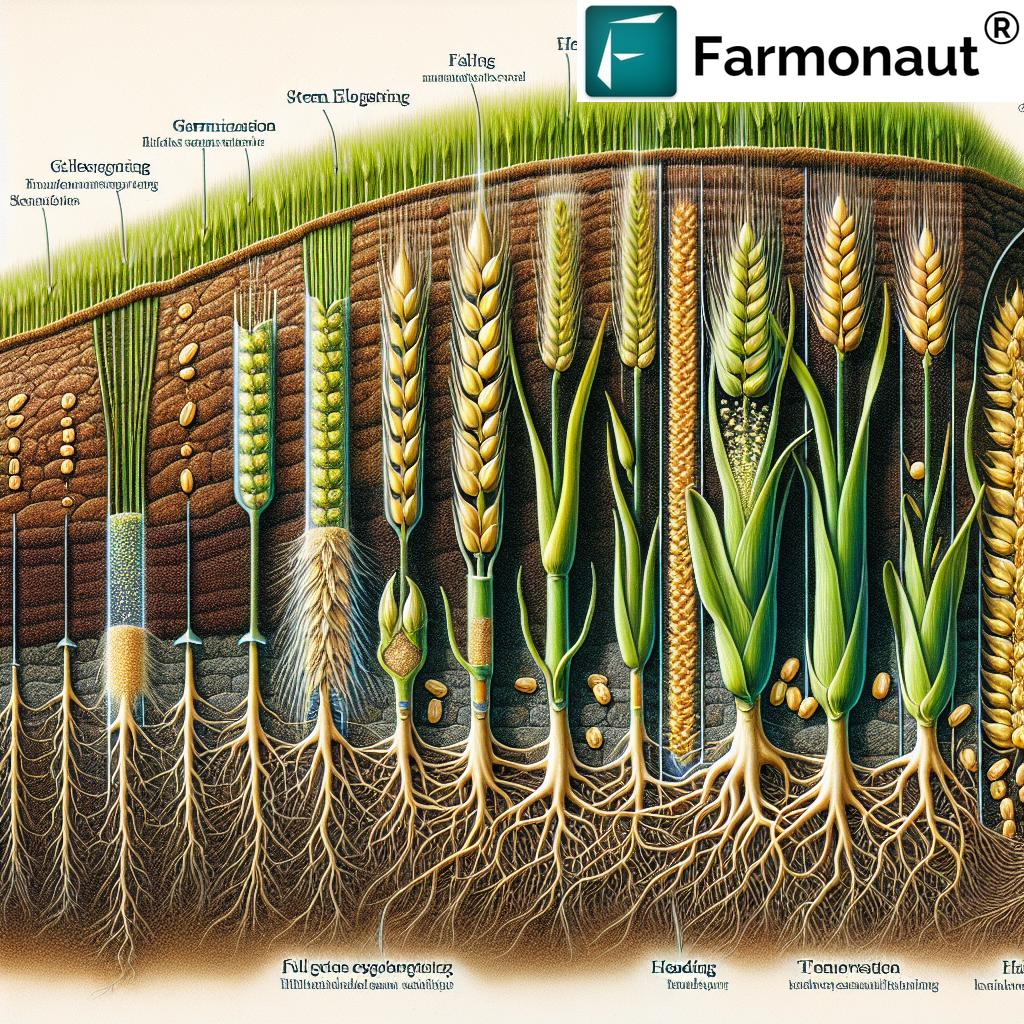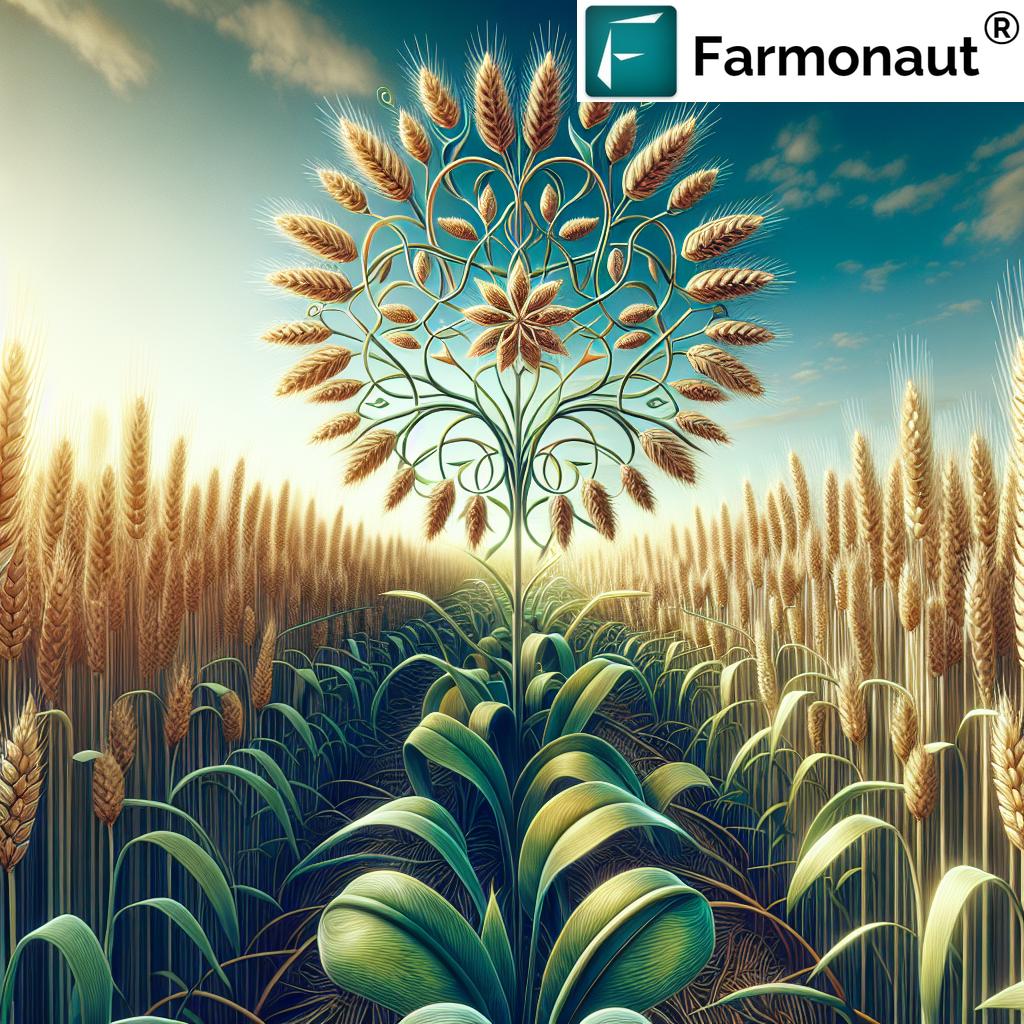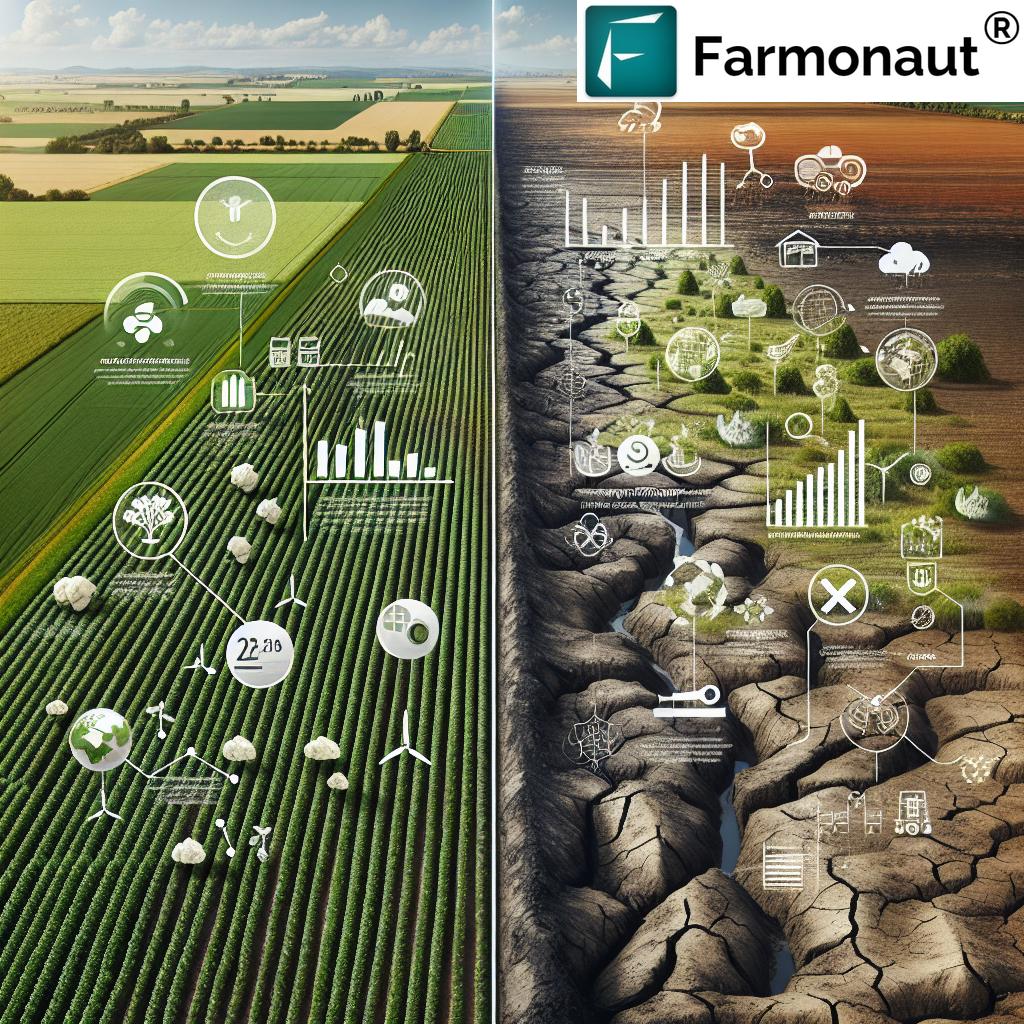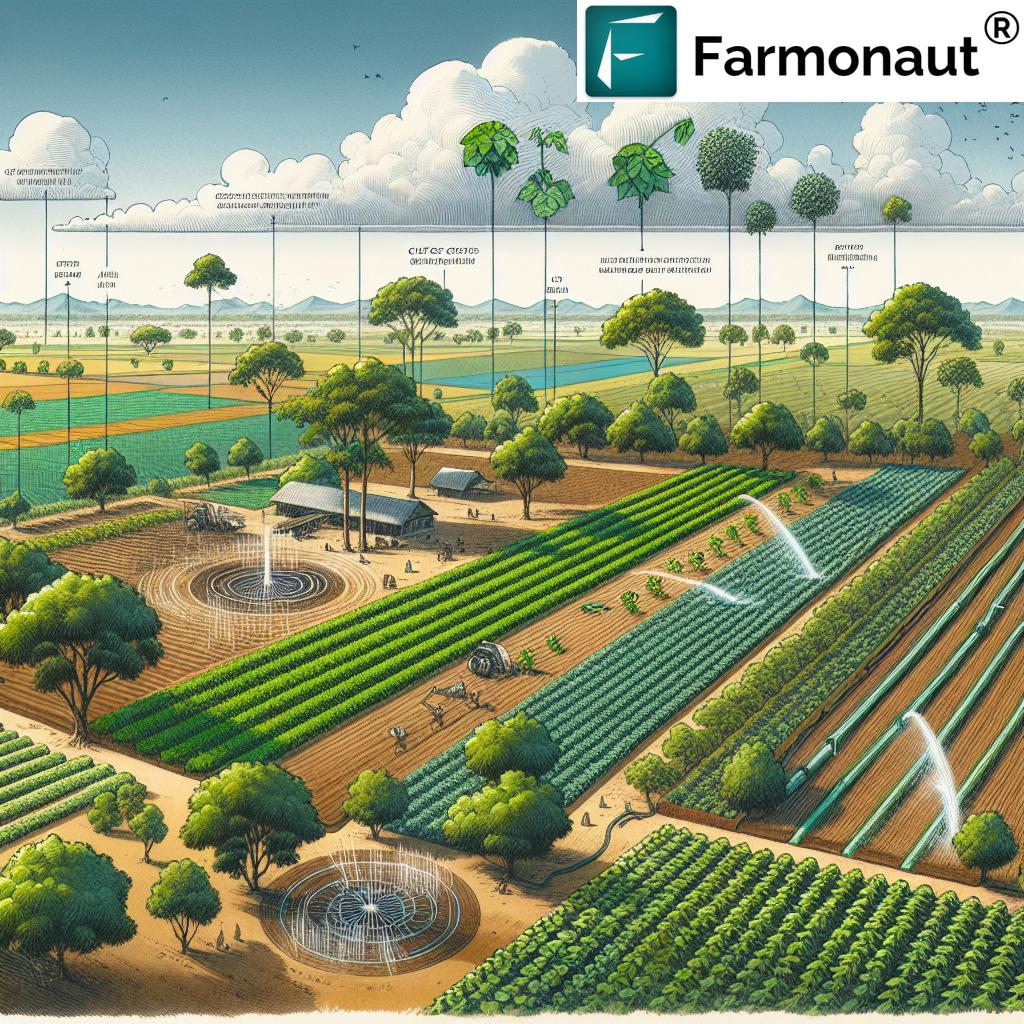Wheat Growth Stages: Essential Guide to Boosting Yields
Table of Contents
- Introduction: The Importance of Wheat Growth Stages
- Wheat Growth Stages and Management Practices Overview
- 1. Germination and Seedling Establishment
- 2. Wheat Tillering Phase
- 3. Stem Elongation (Jointing Phase)
- 4. Booting: Leaf Sheath and Head Development
- 5. Wheat Heading and Flowering (Anthesis)
- 6. Grain Filling in Wheat
- 7. Wheat Maturity and Harvest
- Wheat Growth Stage Classification Systems (Feekes, Zadoks, BBCH)
- Factors Affecting Wheat Yield Potential
- Effective Monitoring & Management Practices
- How Farmonaut Empowers Wheat Growers
- Frequently Asked Questions
- Conclusion: Optimizing Wheat Cultivation Through Understanding Growth Stages
“Wheat can pass through up to 8 distinct growth stages, each crucial for maximizing yield and grain quality.”
Introduction: The Importance of Wheat Growth Stages
Wheat (Triticum aestivum) stands as the cornerstone of global agriculture, serving as a staple food source for billions. As one of the world’s most widely cultivated crops, maximizing wheat yield and maintaining grain quality are enduring priorities for farmers and agronomists alike. However, the path to optimizing yield and grain quality is paved with understanding—specifically, a deep knowledge of the wheat growth stages and the management practices associated with each phase.
From the germination of seeds, through tillering, stem elongation, booting, heading, flowering (anthesis), grain filling, and finally to maturity and harvest, each stage of wheat’s life cycle brings unique physiological changes. These stages determine not only the crop’s health but its ultimate production potential. Navigating the complexities of these growth phases, especially under variable environmental conditions, is crucial to the success of every wheat crop.
In this comprehensive guide, we’ll break down the stages of wheat development, provide actionable tips for management practices for each phase, and highlight how integrating precision technology—like Farmonaut’s solutions—can bring next-level clarity and efficiency to your wheat cultivation.
Wheat Growth Stages and Management Practices Overview
A clear grasp of wheat growth stages allows us to implement yield optimization practices tailored to each phase. Here’s a tabular snapshot:
| Stage Name | Approximate Days After Sowing | Key Visual Indicators | Recommended Management Practices | Impact on Yield |
|---|---|---|---|---|
| Germination & Seedling Establishment | 0-10 | Radicle & coleoptile emergence; first true leaf | Ensure optimal soil moisture, temperature (12°C-25°C); monitor for pests | Very High |
| Wheat Tillering Phase | 10-30 | Lateral shoots (tillers) form | Apply nitrogen; manage density and soil fertility | High |
| Stem Elongation (Jointing) | 30-45 | Vertical growth, node/inter-node elongation | Nitrogen topdressing; irrigation; early disease control | High |
| Booting & Heading | 45-60 | Swollen leaf sheath; head emergence | Monitor for pests, foliar diseases; timely sprays | Very High |
| Flowering (Anthesis) | 55-65 | Anthers visible; pollination | Irrigate if dry; protect from heat stress | Very High |
| Grain Filling | 65-100 | Kernels swell (‘milky’ to ‘hard’ ripe) | Adequate moisture, late fertilization, prevent lodging | High |
| Maturity & Harvest | 100+ | Plants yellowing, kernels harden | Timely harvest; monitor kernel moisture | Moderate (mainly for quality) |
1. Germination and Seedling Establishment
The journey of efficient wheat cultivation begins at the germination stage, a period when wheat seeds absorb water from the soil, triggering metabolic activity and the emergence of the radicle (primary root) and the coleoptile (protective sheath for the shoot). Under optimal conditions—soil temperatures between 12°C and 25°C (54°F – 77°F) and good moisture—seedlings typically emerge within 7 days.
Key processes during this phase:
- Seeds imbibe water, activating enzymes that mobilize energy and nutrients stored in the seed.
- The radicle forms the primary root; the coleoptile protects the emerging shoot as it pushes upward.
- Emergence of the first true leaf signals the transition to independent photosynthesis, making the seedling ‘functional.’
Management Practices for Germination
- Use high-quality, clean, and disease-free seed for maximal field emergence and yield potential.
- Prepare a fine, moist seedbed for good soil contact and rapid root development.
- Monitor sowing depth—ideally 2-4 cm deep for efficient germination.
- Ensure timely irrigation, especially in areas prone to dry spells.
- Monitor for seedling diseases; use fungicidal seed treatments as needed.
Early emergence uniformity is crucial—patchy stands reduce yield potential and complicate management throughout later growth stages.
2. Wheat Tillering Phase
The wheat tillering phase marks a significant step for building yield foundation. After initial leaves form, the main shoot generates lateral shoots known as tillers. Each tiller may later produce its own head.
- This phase is typically initiated when the wheat plant has 3-4 true leaves.
- The number of tillers formed is influenced by:
- Planting density: Too high reduces tiller formation; too low wastes field space.
- Soil fertility: More nutrients, particularly nitrogen, encourage more tillers.
- Environmental conditions: Cool weather and adequate moisture boost tillering.
Management Practices for Tillering
- Apply first nitrogen topdressing during early tillering (especially in nitrogen-deficient soils).
- Monitor fields for weed competition—control is essential as tillers compete for resources.
- Ensure timely irrigation, as moisture stress can severely reduce tiller formation.
- Adjust seeding rates for local conditions to avoid excessive density or thin stands.
“Proper management during the tillering stage can increase wheat yield potential by up to 30%.”
3. Stem Elongation (Jointing Phase) in Wheat
The stem elongation phase, also called jointing, is the period when wheat rapidly gains height. Nodes and internodes (segments between nodes) begin to visibly elongate and the growing point rises above ground level. It is during this phase that the maximum head size and spikelet number are set—a direct determinant of eventual grain yield.
- Look for the first detectable joint above the soil surface—this is the start of stem elongation.
- Optimal growing conditions (18°C–24°C, steady moisture) promote maximal head formation.
- Moisture stress at this phase can result in fewer spikelets per spike and reduced yield potential.
Management Practices during Jointing
- Apply second nitrogen fertilizer application if needed (split applications are often best for yield).
- Ensure uniform and adequate irrigation—water shortages here have high yield cost.
- Scout for potential early disease pressures and begin fungicide programs as necessary.
- Prevent lodging by maintaining balanced N inputs and promptly managing problems.
Farmonaut’s satellite crop health monitoring can help detect issues of uneven growth or moisture deficiency at this stage, improving wheat management decisions.
4. Booting: Leaf Sheath and Head Development
The booting stage begins when the swollen sheath of the flag leaf encases the rapidly expanding head. This phase occurs shortly before heading and flowering (anthesis), and is a critical point for crop monitoring.
- Look for a visibly swollen flag leaf sheath (“boot”), as it contains the developing head.
- This stage is sub-classified by the Feekes scale as:
- Feekes 10.0: Head fully enclosed in the leaf sheath; maximum vulnerability to environmental stress.
- Feekes 10.1: Awns (bristle-like structures) just visible at the sheath opening.
- Feekes 10.5: Head fully emerged from the leaf sheath.
Management and Crop Protection at Booting Stage
- Shield the crop from late-season insects and foliar diseases—protect developing heads.
- Complete any critical foliar feeding by Feekes 10.5 to avoid residue issues at harvest.
- Avoid late irrigation after this stage, as it can increase the risk of disease and lodging.
For those seeking end-to-end quality validation, Farmonaut’s blockchain-based traceability solutions add a layer of transparency to every phase of wheat development, from growth to shipment.
5. Wheat Heading and Flowering (Anthesis)
Heading is the process when the wheat head emerges completely from the flag leaf sheath, signalling the onset of the flowering (anthesis) phase. This is a pivotal event, as the fertilization of flowers will directly determine the number of kernels per head—and thus, potential wheat yield.
- Optimal conditions for flowering: Daytime temperatures of 18°C–24°C (64°F–75°F); low humidity to avert fungal diseases.
- The anthesis period is short (4–5 days), but stress here can severely impact grain set.
- Pollen is shed and fertilization occurs in a bottom-up direction on the head.
Management Practices during Heading and Flowering
- Irrigate judiciously if dry—water stress now causes kernel abortion and less grain filling.
- Evade pesticide applications that might harm pollinators or interfere with pollination.
- Monitor for foliar diseases and apply protective fungicides if needed.
- Scout for aphids, armyworms, and other pests targeting the head.
Environmental extremes—heat, drought, or disease outbreaks—are especially damaging during this phase. Timely monitoring with Farmonaut’s precision agriculture platform can alert you to risks when it matters most.
6. Grain Filling in Wheat
Following anthesis, the wheat plant enters the grain filling phase—a period marked by the accumulation of starch and proteins in each kernel. This determines both yield and grain quality.
- The grain passes through discrete substages:
- Watery Ripe (Feekes 11.1): Kernel filled with faint, milky liquid.
- Milky Ripe (Feekes 11.2): Kernel content thickens to milk-like consistency.
- Mealy Ripe (Feekes 11.3): Doughy, yet still soft kernel interior—critical for protein development.
- Hard Ripe (Feekes 11.4): Kernel becomes hard, dry, and ready for harvest.
- Duration: 30–50 days, depending on temperature, soil moisture, and wheat variety.
Best Practices for Grain Filling
- Maintain steady soil moisture—drought can shrink kernels, reduce yield and quality.
- Apply late fertilization only if necessary and compatible with local policy/practice.
- Keep monitoring for disease—late infections (e.g., rusts, scab) can still reduce yield.
Adequate grain filling ensures heavier, higher-protein wheat kernels, vital for both yield and food quality standards.
7. Wheat Maturity and Harvest
Maturity signifies the end of the wheat growing season. By this point, the plant has ceased photosynthesis, and kernels dry down to optimize harvest quality and storability.
- Physiological maturity: Achieved when kernels are no longer gaining dry matter—usually visible by a black layer at the kernel base.
- Harvest readiness: Kernel moisture content drops to approximately 15%.
- Delayed harvest may lead to grain shattering, weathering, sprouting, or quality decline.
Harvesting Best Practices
- Monitor kernel moisture precisely—too wet risks spoilage, too dry risks shattering and field loss.
- Time harvest to avoid forecasted rains or storms.
- Clean and calibrate harvest machinery to minimize kernel loss.
- Consider Farmonaut’s crop loan and insurance verification tools for safe, transparent crop financing and support during and after harvest.
A timely, well-managed harvest not only preserves maximum yield but also supports a premium wheat grain quality standard for global food supply.
Wheat Growth Stage Classification Systems (Feekes, Zadoks, BBCH)
To streamline crop staging and communications, standardized wheat growth stage classification systems are used globally. Let’s quickly review the most common:
-
Feekes Scale:
- Most widely used in the United States and several global wheat regions.
- Ranges from Feekes 1 (germination) to Feekes 11.4 (harvest readiness).
- Simple, but less precise in reproductive phases.
-
Zadoks Scale:
- More detailed than Feekes, with a two-digit code (00–99) mapping wheat development.
- Facilitates detailed research and agronomy fieldwork.
-
BBCH Scale:
- Internationally standardized system covering all cereal crops.
- Allows for extremely fine-tuned classification of each phase of wheat development and management.
Using these classification systems ensures precision in communication between growers, agronomists, and researchers—an essential for modern, data-driven agriculture.
Farmonaut Satellite API |
Developer Documentation
Factors Affecting Wheat Yield Potential Across Growth Stages
Both genetic (variety-based) and environmental (climate, soil, rainfall) factors affecting wheat yield potential exert different levels of influence at each wheat growth stage. Understanding these interactions allows for precise, timely interventions to secure maximum productivity and profit.
Critical Yield-Influencing Factors for Each Growth Stage:
- Germination: Seed quality, soil moisture, temperature, sowing depth.
- Tillering: Plant density, nitrogen availability, moisture, temperature.
- Stem elongation/jointing: Water supply, nutrient management, pest/disease protection.
- Heading and Flowering: Temperature, humidity, disease outbreaks, pollination success.
- Grain Filling: Water stress, nutrient sufficiency, late-season disease management.
- Maturity and Harvest: Timeliness, weather (rain/humidity), disease presence, lodging risk.
Advanced remote sensing and digital advisory tools—such as Farmonaut’s Jeevn AI-based farm advisory system—help growers analyze these multiple factors in real time, ensuring each stage receives optimal attention.
Monitoring and Management Practices for Wheat Crop: Maximizing Quality and Yields
Yield optimization isn’t just about strong starts or timely harvests—it’s about consistently aligning management decisions to the physiological needs of wheat at each growth stage. Here’s a summary of key management practices:
Best Wheat Management Practices by Key Stage:
- Soil Testing before Sowing: Understand local fertility for balanced nutrition throughout development stages.
- Integrated Weed and Disease Management: Regular field scouting, targeted application of pesticides/herbicides, and use of disease-resistant wheat varieties.
- Optimized Nitrogen Fertilization: Split application—early (at sowing/tillering) and topdressing at stem elongation/jointing.
- Efficient Water Management: Avoid moisture stress at critical points: germination, tillering, jointing, and grain filling.
- Precision Monitoring: Leverage technologies such as Farmonaut’s satellite-based real-time crop monitoring for disease detection, stress analysis, irrigation scheduling, and estimating potential yield throughout the wheat season.
- Timely Harvesting: Regularly monitor kernel moisture to determine the precise harvest window; don’t delay!
For organizations managing expansive crop areas, comprehensive solutions for fleet management and carbon footprinting are also available, helping optimize operations and sustainability across all wheat growth stages.
How Farmonaut Empowers Wheat Growers at Every Growth Stage
We at Farmonaut are committed to making precision agriculture accessible and affordable for growers across the world. By leveraging cutting-edge satellite imagery, AI-driven analytics, and blockchain technology, we enable farmers to monitor, analyze, and act across every crucial wheat growth stage. Here’s how our platform transforms wheat cultivation:
- Satellite Crop Health Monitoring: Near real-time insights on canopy vigor, soil moisture, plant health, and problem detection. (NDVI, EVI, other indices)
- Jeevn AI Advisory: Automated, personalized management advice—stage-wise irrigation, fertilization, and pest/disease warnings for every wheat field!
- Blockchain Traceability: Transparent supply chain validation, tracking each stage of wheat development, from seeding to shipment.
- API & App Integrations: Instant access to growth, weather, and resource data for agribusinesses, developers, and governments via our APIs.
- Fleet and Resource Management: For agribusiness and cooperatives to optimize farm logistics and machinery across seasons and wheat stages.
- Carbon Footprinting Support: Real-time environmental impact tracking—making sustainable wheat farming more measurable and actionable.
All features are accessible through our web & mobile apps, designed for farmers, advisors, researchers, and businesses of every size.
Frequently Asked Questions (FAQ) on Wheat Growth Stages
1. What are the main wheat growth stages?
The major stages include: Germination and Seedling Establishment, Tillering, Stem Elongation (Jointing), Booting, Heading, Flowering (Anthesis), Grain Filling, and Maturity and Harvest. Recognizing these phases ensures timely management and higher yields.
2. How can I identify the tillering stage in wheat?
Tillering begins when the wheat plant develops lateral shoots (tillers) from the base after 3-4 leaves. The number of tillers dramatically impacts final yield.
3. Why is the Feekes scale important in wheat management?
The Feekes scale standardizes the description of development in wheat, aiding precise communication for agronomy advice, crop monitoring, and field trials.
4. What practices should be prioritized during wheat heading and flowering?
Ensure adequate moisture, protect against diseases (especially fungicide applications), and avoid stressful pesticide interventions. Timely, proactive management is crucial for optimizing grain set and quality.
5. How does Farmonaut help with wheat growth stages?
We provide real-time crop health, moisture, and resource monitoring, AI-based, stage-wise management advice, blockchain traceability for supply chains, and decision support for farm operations—empowering you at every growth stage for optimal wheat yield and quality.
Conclusion: Optimizing Wheat Cultivation Through Understanding Growth Stages
Understanding and monitoring the wheat growth stages is not simply academic—it’s the practical key to unlocking optimum yields and grain quality for one of the world’s most important crops. Each phase, from germination to harvest, presents unique opportunities and management challenges. By aligning fertilizer, irrigation, pest, and disease control precisely to stage-specific needs, farmers lay the foundation for successful, resilient wheat cultivation.
Today’s innovations in remote sensing, artificial intelligence, and digital traceability, such as those we offer at Farmonaut, now enable unprecedented precision and sustainability in wheat farming practices. Together, we can help secure food for tomorrow’s generations with smarter, more adaptive management at every growth stage.
For more detailed management resources and to experience real-time wheat growth stage monitoring, download the Farmonaut app or explore our API solutions for farm and agribusiness integration.
Maximize your wheat yield this season—make every stage count!












